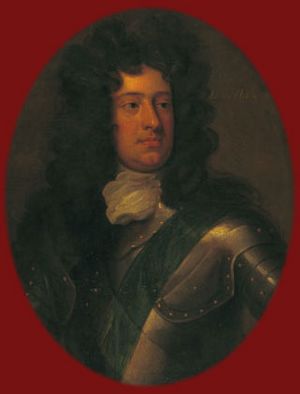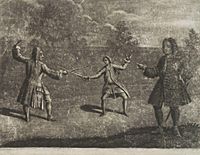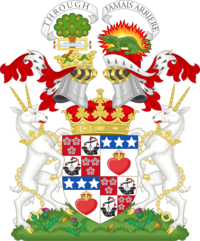James Hamilton, 4th Duke of Hamilton facts for kids
Quick facts for kids
The Duke of Hamilton
|
|
|---|---|

The 4th Duke of Hamilton
|
|
| Born | 11 April 1658 Hamilton Palace, Lanarkshire, Scotland |
| Died | 15 November 1712 (aged 54) London, England |
| Other titles | 1st Duke of Brandon Marquess of Clydesdale Earl of Arran, Lanark and Cambridge Baron Dutton Lord Aven, Polmont, Machansyre, and Innerdale |
| Nationality | Scottish |
| Offices | Master of the Great Wardrobe Keeper of the Palace of Holyroodhouse Master-General of the Ordnance |
| Spouse(s) |
Anne Spencer
(m. 1686; died 1690)Elizabeth Gerard
(m. 1698) |
| Issue | Lady Elizabeth Hamilton Lady Catherine Hamilton Lady Charlotte Edwin James Hamilton, 5th Duke of Hamilton Lord William Hamilton Lady Susan Hamilton Lord Anne Hamilton Sir James Abercrombie, 1st Baronet Charles Hamilton, Count of Arran |
| Parents | William Douglas, 1st Earl of Selkirk Anne Hamilton, 3rd Duchess of Hamilton |
|
|
|
Lieutenant-General James Hamilton, 4th Duke of Hamilton and 1st Duke of Brandon (born 11 April 1658 – died 15 November 1712) was an important Scottish nobleman, soldier, and politician. He was a big investor in the Darien Scheme, a failed plan that cost many rich Scots their money. He also led the group in the Parliament of Scotland that was against the Act of Union in 1707. James Hamilton died in a famous duel in Hyde Park over a family inheritance dispute.
Contents
Early Life of James Hamilton
James Hamilton was born at Hamilton Palace in Lanarkshire, Scotland. His father was William Douglas, who became the Duke of Hamilton for his lifetime. His mother was Anne, 3rd Duchess of Hamilton, who held the title in her own right.
Because his mother was a descendant of the Scottish House of Stewart, James had a strong claim to the thrones of both Scotland and England. He was taught by private teachers at home. Later, he attended the University of Glasgow.
Travels and Early Career
After university, James went on a "Grand Tour" of Europe. This was a popular trip for young noblemen to learn about other countries. For many years, he was known as the Earl of Arran.
In 1679, King Charles II made him a Gentleman of the Bedchamber. This was an important role in the royal court. In 1683, he became an ambassador to the court of King Louis XIV of France. He stayed in France for over a year and even fought in two campaigns with the French army.
When he returned to Great Britain, King James VII and II gave him the same important jobs. In 1687, King James made him one of the first knights of the royal Order of the Thistle. After King James was removed from power, James Hamilton was arrested twice. People thought he was involved in plots to bring James back, but he was released without any charges.
Becoming the Duke of Hamilton
James's father passed away in 1694. In 1698, his mother gave up all her titles to King William. A month later, King William gave these titles back to James. This happened at Het Loo in the Netherlands.
He was confirmed as the Duke of Hamilton, along with other important titles. King William likely did this because James's parents had been loyal. However, James himself was sometimes suspected of supporting the old royal family, the Stuarts. He was even arrested more than once for these activities.
Big Decisions for Scotland
James Hamilton was a key figure in Scottish politics. He was involved in two major events that shaped Scotland's future.
The Darien Scheme
Hamilton was part of a group that supported the Darien scheme in the Parliament of Scotland. This was a plan to set up a Scottish colony in Central America. He and his mother invested a lot of money in it.
However, the expedition failed badly. Scotland lost a huge amount of money, about 20% of all the money in the country at the time. This failure caused a lot of anger and financial problems for Scotland.
The Act of Union
After the Darien Scheme failed, people started talking seriously about uniting Scotland and England. Hamilton was seen as the leader of the group that was against this union. He had a strong claim to the Scottish throne because he was a descendant of the Scottish House of Stewart.
If Scotland chose not to accept the new heir to the English throne, James Hamilton and his family would be next in line for the Scottish throne. However, his actions during this time were not very clear. He seemed to switch between supporting the King and supporting the Scottish people.
On the day of the final vote for the union, Hamilton was not there. He stayed in his rooms, saying he had a toothache. The Acts of Union were passed, which meant Scotland and England became one country, Great Britain. Many people in Edinburgh were very angry, and there were riots. Hamilton had missed his chance to secure the Scottish throne for his family.
Life After the Union
In 1708, Hamilton was chosen as one of 16 Scottish noblemen to represent Scotland in the new British Parliament. In 1711, he was given a new title: Duke of Brandon in England.
This new title caused some debate about whether he could sit in the English Parliament. This issue was not fully settled until much later, for his grandson. Besides the Dukedom, he was also made Baron Dutton. In October 1712, he became a Knight of the Garter. This made him the only person who was not a royal to be a knight of both the Thistle and the Garter.
A Famous Duel and His Death
On 15 November 1712, James Hamilton fought a famous duel with Charles, Lord Mohun. This duel happened in Hyde Park in London.
The Reason for the Duel
The duel was about a disagreement over a large family inheritance. A rich man named Fitton Gerard had died without children. Hamilton claimed the estates through his wife, Elizabeth Gerard. Lord Mohun also claimed the estates because he was named as an heir by another family member.
Years of legal arguments followed. Finally, Lord Mohun challenged Hamilton to a duel.
The Duel and Its Aftermath
The duel took place on the morning of November 15th. Hamilton, who was older, seriously wounded Mohun. But Hamilton was also badly wounded himself and died.
After the duel, Hamilton's assistant claimed that Mohun's assistant had also attacked Hamilton. However, there was no clear proof of this. Questions were raised about why Hamilton's assistant did not try to arrest Mohun's assistant if a crime had happened. Mohun's assistant escaped to Europe. He was later tried for murder while he was away, but he was eventually pardoned.
Family Life
James Hamilton was married twice and had several children.
First Marriage
In 1686, he married Lady Anne Spencer. They had two daughters, but sadly, neither of them lived past childhood. Anne passed away in 1690, shortly after their second daughter was born.
Second Marriage
In 1698, Hamilton married Elizabeth Gerard. They had seven children together:
- Lady Elizabeth Hamilton (1699–1702)
- Lady Catherine Hamilton (c. 1700 – 1712)
- Lady Charlotte Hamilton (c. 1701 – 1774), who married Charles Edwin.
- James Hamilton, 5th Duke of Hamilton (1703–1743)
- Lord William Hamilton (c. 1705 – 1734)
- Lady Susan Hamilton (c. 1706–1753), who married Anthony Keck.
- Lord Anne Hamilton (1709–1748), whose family line continued to become later Dukes of Hamilton.
Other Children
James Hamilton also had four other children:
- Lt. Col. Sir James Abercrombie, 1st Baronet, who became a military officer and a Member of Parliament.
- Sir Charles Hamilton, who lived in France and was known as Count of Arran. He also had a son who became a military officer.
- Two daughters named Ruthven.
Coat of Arms




